by
Christine Erratt
(click on photos to enlarge image)
FROM VILLA ADRIANA TO AUSTRALIA
Australian Open Tennis Tournament Trophy
On 1st February this year, twenty two year old Spaniard
Rafael Nadal won the 2009 Australian Open Tennis Championship in
front of an enthusiastic crowd - enthusiastic both for the
champion and the runner-up, Roger Federer of Switzerland. There
was a huge television viewing audience also. They battled each
other for over four hours for the title - and for the trophy and
prize money. The Australian Open is one of the four Grand Slam
Tournaments along with the French Open, Wimbledon and the US
Open.
Any Silverphile’s heart would have raced seeing the mighty
silver trophy presented to Nadal held high above his head like
an offering to the ancient gods.
 |
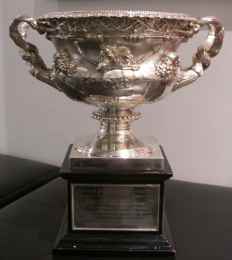 |
Rafael Nadal and the
Australian Open perpetual trophy
photo: Sina English website
|
The perpetual trophy on its plinth
|
The Australian Open tennis tournament commenced in 1905
under the auspices of the Lawn Tennis Association of Australia.
It was played on grass courts until 1987 and in 1988 the era of
hard courts began. It is now managed by Tennis Australia. The
perpetual trophy presented to the winner of the Men’s Singles is
called the Norman Brookes Challenge Cup, so named after the late
Sir Norman Brookes (1877-1968), a former Australian tennis
champion and a former president of the Lawn Tennis Association
of Australia.
This large silver trophy was made in England. It bears London
hallmarks for the year 1906 and the sponsor’s mark of Hardy Bros.
(note 1)
 |
|
London hallmarks for the year 1906 and the
sponsor’s mark of Hardy Bros
|
The diameter of the bowl is 25.7cms (10 ins); including its
handles the all over width is 39cms (15 ins). Its height is
28cms (11 ins) and it stands on a plinth of 15.5cms (6 ins).
It was based on the design of a very large Roman marble vase
from the second century AD. The fragmented vase was found in
c1770 by Gavin Hamilton, a Scottish painter, antiquarian and art
dealer, in the silt of a marshy pond in the extensive grounds of
Hadrian’s villa, Villa Adriana.
(note 2) Hadrian was the Roman Emperor in the years
AD117-138. Villa Adriana was a grandiose imperial palace located
just outside ancient Tibur, modern Tivoli, 28km east of Rome.
The sumptuous villa complex of over 30 buildings covered an area
estimated to be between 100-300 hectares. It was Hadrian’s
preferred residence when he was not on travels away from Rome.
The villa was designed to surpass all others and was adorned
with the very best of what the Roman Empire had to offer in
terms of works of art. It is assumed that this large and
elaborately decorated vase or urn was specially made to adorn
his palatial villa. Almost everything of value has been removed
from the site and many objects are now dispersed throughout
Europe in museums and collections, both public and private.
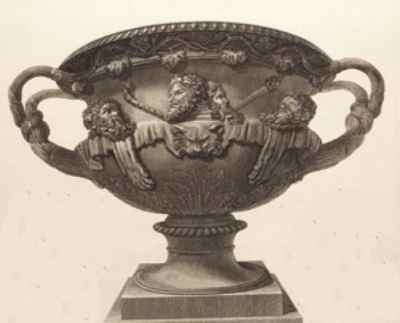 |
|
The restored marble vase from Villa Adriana
from a 1778 engraving by Giovanni Battista
Piranesi
photo: Smithsonian Institution website
|
The fate of the fragments of the marble vase was that they
were purchased by Gavin Hamilton’s namesake and fellow Scot,
William Hamilton (1730-1803), who was the British envoy to the
Kingdom of Naples and the Two Sicilies at that time.
(note 3) He was a noted diplomat, antiquarian,
archaeologist and vulcanologist. During his time as British
envoy he studied local volcanic activity and earthquakes and
collected Roman and Etruscan vases and other antiquities,
particularly from the then recently excavated ruins of Pompeii
and Herculaneum. Over the next two years William Hamilton saw to
the repairs and restoration of the vase.
The restored marble vase is colossal, standing itself at 184cms
(6ft). Including its pedestal, which is approximately 110cms
(3ft 7ins) high, The combined height is 294cms (9’7’’) and
combined weight is 8¼ tons. It has two large handles depicting
interwoven vine branches, from which the tendrils, leaves and
clustering grapes spread around the upper margin. It features
classical Bacchanalian masks and associated emblems.
In 1772 William Hamilton offered part of his collection of
antiquities to the British Parliament for sale and subsequently
those purchased entered the collections of the British Museum.
This stimulated an English interest in the art of the classical
civilisations and is considered to have had a great influence on
the evolution of English taste. The pottery business partnership
of Josiah Wedgwood and Thomas Bentley (1769-1780) was
particularly influenced by Hamilton’s collections of Etruscan
vases, and profited greatly from its production of vases in the
antique manner, many in black basalt painted to imitate
classical origins. Hamilton, who was knighted in 1772, was
immortalised in one of their portrait plaques.
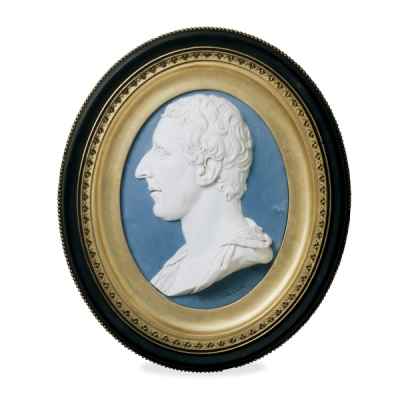 |
|
1779 Wedgwood & Bentley jasperware plaque
of Sir William Hamilton in the classical style
photo: British Museum website
|
However, the particular marble vase of our interest was not
purchased by the British Museum. Sir William later (c1776)
passed it over to his elder nephew in England, George Greville,
2nd Earl of Warwick and 2nd Earl Brooke of Warwick Castle.
(note 4) After some years of the vase being on
display on the lawns of Warwick Castle, a greenhouse was
designed and built (1786-1788) in the grounds of the castle to
display the vase in a more satisfactory climate. It attracted
large crowds and is said to have became one of the most coveted
objects in Europe. By this stage it had become known as the
Warwick Vase.
Not only did the potteries of England enjoy greater business
opportunities because of the surge in interest in ‘objets
classiques’ but so too did the gold and silversmiths, who made
replicas in silver and silver gilt. Engravings of the vase were
made by Giovanni Battista Piranesi in 1778 and these prints
provided the inspiration for reproductions of the vase. The
design lends itself to reproductions being used not only as
vases or urns but also as wine coolers, ice pails, bowls,
tureens, centrepieces, salts and trophies. In England, Paul
Storr was probably one of the most prolific producers of silver
and silver gilt replicas of the Warwick Vase in the Regency
Period. Many have been identified with his maker’s mark on them.
In the period 1812-1816 the Prince Regent commissioned a set of
12 silver gilt ice pails in the Warwick Vase style from the
Royal goldsmiths Rundell, Bridge and Rundell, where, at that
time, Storr was a partner. They have Paul Storr’s mark on them
and they remain to this day in the Royal Collection at Windsor
Castle. Amongst the others who have taken up the challenge
since the early years of the nineteenth century are Matthew
Boulton, Benjamin Smith, Elkington & Co, Walker & Hall, E Barnard
& Sons and the Goldsmiths & Silversmiths Company.
In America, Fletcher & Gardiner also made fine replicas in silver,
as did Joseph Germain Dutalis in Belgium. One of the most well known Chinese
Export Silver silversmiths, Khecheong, also made replicas in his
Canton workshop in the late nineteenth century.
Apart from only three full size replicas, the many other
replicas are smaller in size, as in 1813 the Earl of Warwick
placed a ban on any other reproductions being made true to
scale. Shortly after 1813 two were permitted to be made of the
same dimensions. They were cast in bronze and are now at the
University of Cambridge and at Windsor Castle, both in England.
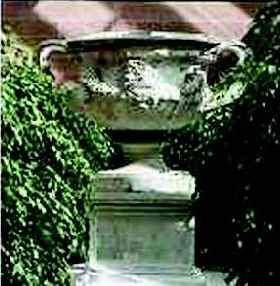
|
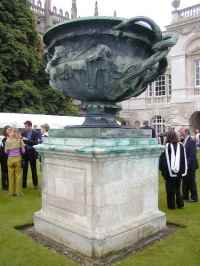 |
Restored vase from Villa Adriana
photo: Burrell Collection website
|
Cast bronze replica of the Warwick Vase
photo: University of Cambridge website
|
The so-called Warwick Vase stayed on display at Warwick
Castle until it was sold in London in 1978. Its disposal has led
to the third full scale replica being displayed thereafter at
Warwick Castle. The Metropolitan Museum of Art in New York
purchased the vase. However it was then declared to be an object
of national importance and an export licence was denied. It was
subsequently bought in 1979 by the Burrell Collection in
Glasgow, Scotland, where it now stands in the middle of the
museum’s internal courtyard, attracting much attention and
interest.
It is almost two millennia since Hadrian arranged for artisans
to create things of beauty to decorate his villa. Reproductions
of the Warwick Vase have been produced in silver; bronze; iron;
and other metals; porcelain; stone; and plates and medallions
have been adorned with images. Even on the other side of the
world in Australia each year, a silversmith creates a
silver-plated replica of Hadrian’s marble vase. It becomes the
trophy which the winner of the Australian Open can keep for
himself. The complicated and intricate decoration offered a real
challenge when the model was being prepared for casting. This
half size replica is made in Australia by Terence County, a
Melbourne silversmith. County has been running his own business
in Melbourne, Victoria since 1972, specialising in trophies and
restoration work. The trophy is marked with the maker’s incuse
mark: T.COUNTY
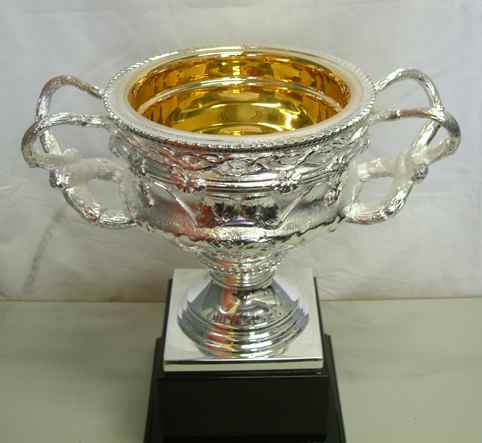 |
|
Australian Open tennis tournament small
replica trophy made by Terry County
|
Acknowledgements.
I am indebted to Terry County for his assistance with all
aspects of the original research into the Australian component
of this article. All other information is a result of my
reviewing many articles available online. As often occurs with
such ‘secondary research’ there were many conflicting
‘statements of facts’. Any such conflicting statements have been
referred to the Burrell Collection Curator of European Art
1600-1800, Mr Robert Wenley, who has kindly supplied the answers
to the best of this knowledge.
ENDNOTE
(note 1) It is stated that the silver trophy was made for
presentation at the first tournament in 1905. However, the
hallmarks show a year date for May 1906 - April 1907.
(note 2) Gavin Hamilton had excavation rites to the site from
1770- early 1771. It is not known at which stage during this
time that the particular fragments were found.
(note 3) It is not known with certainty whether Gavin Hamilton
sold the fragments to William Hamilton or to the artist,
Giovanni Piranesi, who then may have on sold them to William
Hamilton.
(note 4) It is uncertain whether he gifted it or sold it to the
Earl.
Christine Erratt - 2009 -
Christine Erratt is a researcher with a special interest
in Australian contemporary silver.
Her book, Marks on Australian Silver 1950-2005, will be
published later this year.
|
|
|
 ASSOCIATION OF SMALL COLLECTORS OF ANTIQUE SILVER
ASSOCIATION OF SMALL COLLECTORS OF ANTIQUE SILVER






